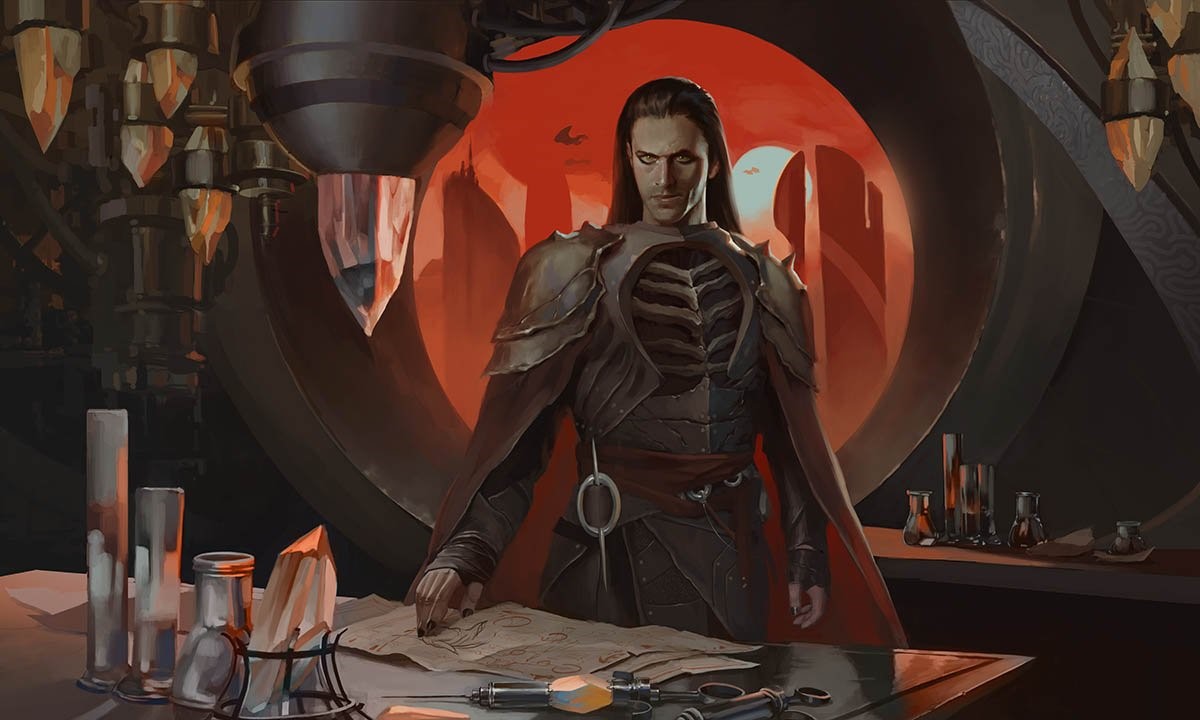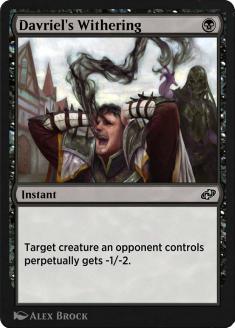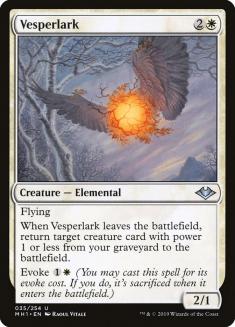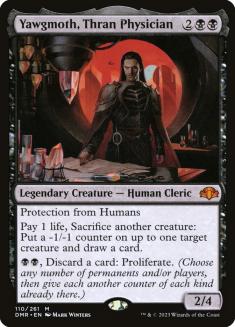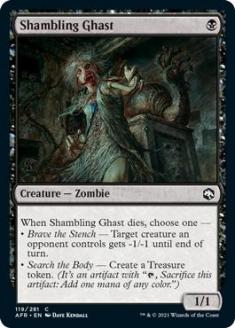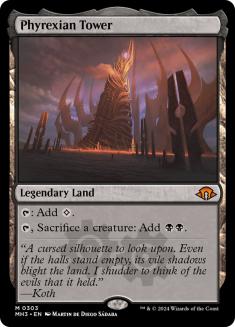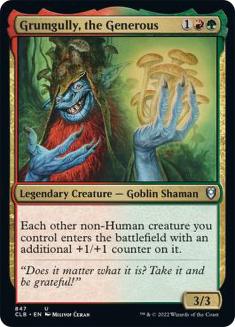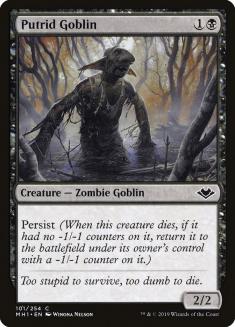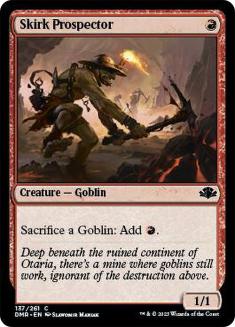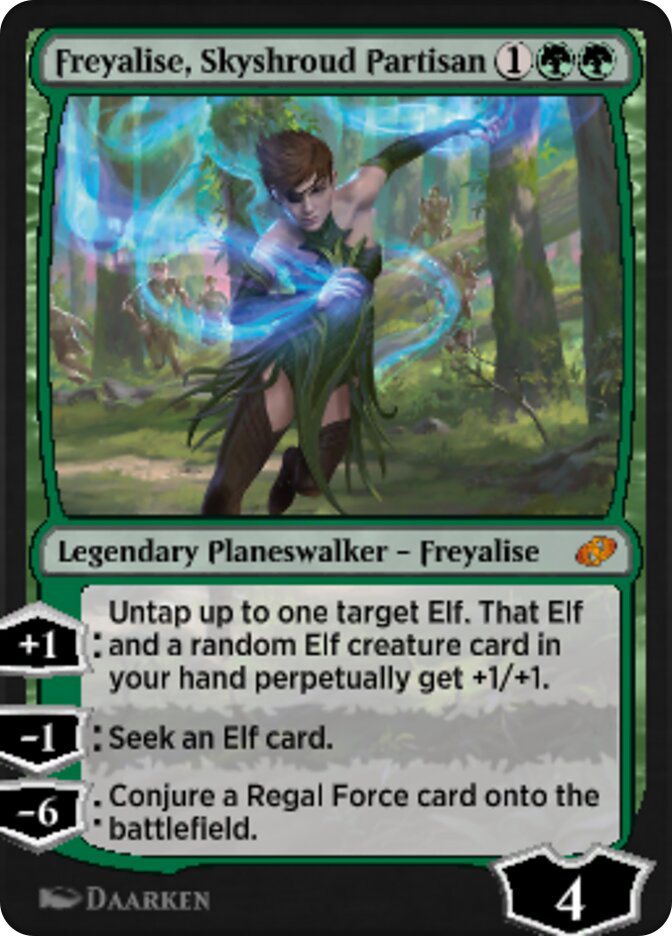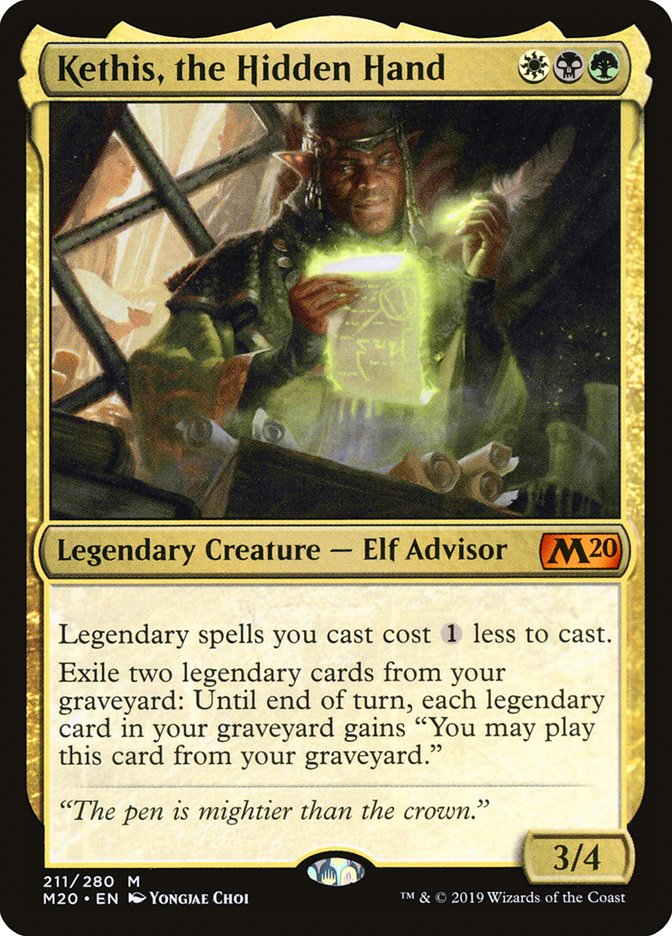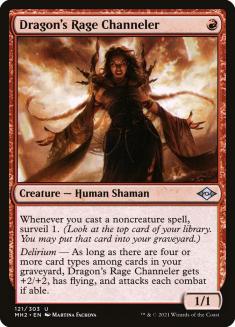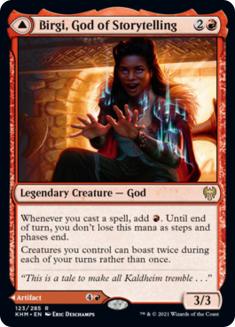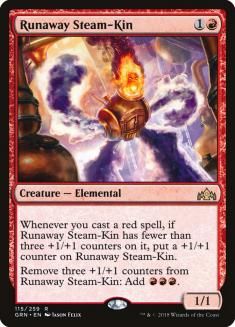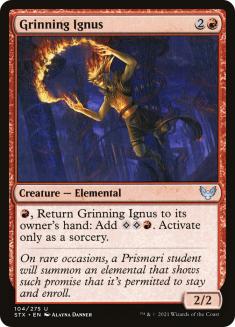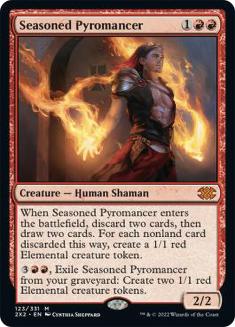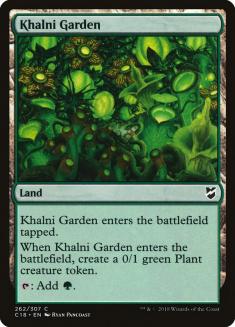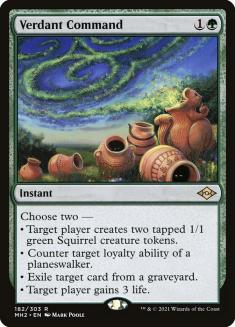Jumpstart: Historic Horizons is about to hit MTG Arena (CEDitor’s Note: Or is it…?). The last person who could safely claim to know what cards in Historic has been forced into retirement and wildcards are about to disappear at a dizzying rate.
This method of injecting cards into Historic is familiar — even if we still have no official vision for what rules meant to govern the format — but this is on a scale we’ve never seen before. The set also breaks new ground in forking digital Magic away from the tabletop game with perpetual effects and other mechanics like conjuring that are impossible to implement cleanly or at all outside a digital client.
This was an inevitable move that opens up fascinating design space and allows Magic to break the shackles that don’t constrain the online-only card games that are direct competition for Arena. I have no ideological objection to this; my problem is that they didn’t go far enough! We’re crossing this line and making a fundamental break with Magic as we know it, but the most exciting thing I can do is conjure a Kraken Hatchling?!
1. Davriel’s Withering
This is by far the most important of the ‘perpetual’ cards and it reads as little more than a second-rate Dead Weight. Davriel’s Withering shows up here because it opens up a combo that’s only possible with perpetual effects. If you put Withering on a Vesperlark, it dies and can return itself as it now perpetually has one power… and zero toughness, so it immediately dies and this cycle repeats. You can combine this with anything that cares about creatures dying (Blood Artist, Cruel Celebrant) or entering the battlefield (Prosperous Innkeeper), but anything that doesn’t end the game as part of this loop runs into issues with how MTG Arena handles repeated actions (though you can turn this to your advantage as the base two-card combo lets you force a draw if you have no other valid targets for Vesperlark).
Building around this combo is a lot of work for little reward, but we can slot it into an existing shell that already has some interest in Vesperlark:
Creatures (28)
- 4 Llanowar Elves
- 4 Blood Artist
- 4 Priest of Forgotten Gods
- 4 Vesperlark
- 4 Woe Strider
- 4 Prosperous Innkeeper
- 4 Shambling Ghast
Planeswalkers (1)
Lands (23)
Spells (8)

This adaptation of the Golgari/Jund Sacrifice shell with Bolas’s Citadel makes great use of the Vesperlark combo payoffs in Blood Artist/Prosperous Innkeeper and can pair Vesperlark with Priest of Forgotten Gods or Woe Strider to good effect. At that point spending the remaining slots on Davriel’s Withering is a low cost, especially without the deckbuilding constraints of Collected Company.
There’s more good news for anyone who enjoys sacrificing creatures…
2. Yawgmoth, Thran Physician
Yawgmoth, Thran Physician doesn’t get to endlessly recycle undying creatures in Historic but it’s the perfect payoff for a more conventional Sacrifice deck. Lists without red get an even better version of Mayhem Devil’s crowd control without having to splash another colour; lists with red get to double down on that effect and make life impossible for any creature deck. I’m writing here about the weird and wacky combo decks that may emerge with Jumpstart: Historic Horizons, but some of the main beneficiaries of the set are synergistic creature decks. If Thalia’s Lieutenant and Esper Sentinel are everywhere in a few weeks, there’s no better response than Yawgmoth. Against non-creature decks, Yawgmoth lets you cash in your meaningless material to dig for a relevant payoff.
Creatures (34)
- 4 Llanowar Elves
- 4 Blood Artist
- 4 Priest of Forgotten Gods
- 4 Yawgmoth, Thran Physician
- 4 Gilded Goose
- 2 Lovestruck Beast
- 4 Woe Strider
- 4 Prosperous Innkeeper
- 4 Shambling Ghast
Lands (22)
Spells (4)

The Golgari Citadel deck with Yawgmoth builds itself but the Phyrexian physician may revive a similar deck that’s fallen on hard times:
Creatures (30)
- 1 Massacre Wurm
- 4 Cryptbreaker
- 1 Ravenous Chupacabra
- 4 Stitcher's Supplier
- 4 Priest of Forgotten Gods
- 4 Yawgmoth, Thran Physician
- 4 Woe Strider
- 4 Fiend Artisan
- 4 Shambling Ghast
Lands (21)
- 17 Swamp
- 4 Phyrexian Tower
Spells (9)

Mono-Black God-Pharaoh’s Gift was replaced by similar but more stable decks that were less reliant on the graveyard but Yawgmoth is at its absolute best here. It complements Gate to the Afterlife perfectly by giving you more cards to loot away while making the most of Gate’s life buffer, offers a backup plan (that Fiend Artisan can find!) that dodges the artifact removal and graveyard hate that opponents will reach for in sideboard games, and lets you interact with a wide battlefield that can shrug off a Priest of Forgotten Gods activation. Between Cryptbreaker, Fiend Artisan, Yawgmoth, and Priest (in matchups where that’s your best card), you have a wide range of strong starts that don’t rely on Gate to the Afterlife.
Shambling Ghast may somehow be an even more crucial pickup. It’s another one-drop Zombie for Cryptbreaker that reduces the pressure to play mopey Lazotep Reavers and the Treasure token in conjunction with Priest of Forgotten Gods or Phyrexian Tower makes it easier to cast and activate Gate to the Afterlife in a single turn, hard-cast a drawn God-Pharaoh’s Gift, or build towards a big Agadeem’s Awakening (a worthy goal to chase when you have Priest of Forgotten Gods and Fiend Artisan as important two-drops).
The interaction with Phyrexian Tower is especially potent and will remind people why Tower was once talked about as the best card in Historic. Casting a four-drop on Turn 2 is incredibly powerful and Jumpstart: Historic Horizons’s resident Physician is the ideal candidate.
If you want to sacrifice creatures but enjoy some Boggart Shenanigans, Jumpstart: Historic Horizons is here for you:
Creatures (32)
- 4 Goblin Matron
- 4 Skirk Prospector
- 4 Goblin Chieftain
- 4 Wily Goblin
- 2 Munitions Expert
- 1 Pashalik Mons
- 4 Putrid Goblin
- 4 Grumgully, the Generous
- 4 Muxus, Goblin Grandee
- 1 Battle Cry Goblin
Lands (24)
Spells (4)

Putrid Goblin allows Skirk Prospector and Grumgully, the Generous to generate infinite mana for Battle Cry Goblin, Pashalik Mons, or Den of the Bugbear (each activation adds another attack trigger, giving you as many Goblins as you need for lethal) and infinite Goblin appearances for another new option in Hobgoblin Bandit Lord. Goblin Matron and Collected Company (with the backdoor route of Company into Matron) make assembling this combo relatively easy and each piece has non-combo applications. Grumgully acts as another Lord a la Goblin Chieftain that makes each individual Goblin better and Collected Company much more threatening while Putrid Goblin pairs with Phyrexian Tower or Skirk Prospector for a burst of mana across several turns to work towards Muxus, Goblin Grandee — the Collected Company / Bolas’s Citadel mashup that may still be the single scariest card for an opponent to resolve in Historic.
There’s more to this next tribal incentive than meets the eye:
3. Freyalise, Skyshroud Partisan
At first glance Freyalise, Skyshroud Partisan is as fair as a card can be, competing with the likes of Imperious Perfect and Marwyn, the Nurturer as a background singer for Magic’s pluckiest tribe. That seemed dangerously weak before this latest batch of assorted nonsense and there’s nothing on the order of Heritage Druid in this set to make that more appealing.
Instead of Elves, why not play exactly one Elf and turn Freyalise into a direct tutor with the promise of more?
Creatures (22)
- 4 Hope of Ghirapur
- 1 Teshar, Ancestor's Apostle
- 4 Diligent Excavator
- 3 Lazav, the Multifarious
- 4 Kethis, the Hidden Hand
- 4 Emry, Lurker of the Loch
- 2 Lurrus of the Dream-Den
Planeswalkers (6)
Lands (24)
Spells (8)

Kethis Combo has been Magic’s strangest Rube Goldberg machine since the initial prototype took Standard by storm. After a short reign there and a preemptive ban in Pioneer, Kethis failed to gain traction in Historic — in part because it is completely reliant on its namesake without the redundancy to excuse that. You can jump through hoops with Wishclaw Talisman or reanimation, but these are all conditional or require more setup than you can usually afford in a cutthroat Historic format.
Freyalise, Skyshroud Partisan isn’t just a guaranteed copy of Kethis, the Hidden Hand. It’s a legendary permanent in a deck that wants to make its Mox Ambers active and needs a high density of legends to exile to Kethis. If you have Kethis but can’t combo this turn, rebuying a Freyalise gives you access to a backup copy of Kethis in case the first one bites the dust.
Kethis enthusiasts often cite the deck’s ability to play a fair game with its planeswalkers and other threats (notably Esika’s Chariot now) when the combo is off the table. Freyalise is a small piece of that puzzle, but a piece nonetheless.
In discussing Kethis’s potential in Pioneer, Ross Merriam highlighted three useful metrics for judging combo decks: speed, resilience, and consistency. This Historic version is less resilient than I’d like but has the speed to keep up with existing linear decks and the ones I mention here. Freyalise is a crucial boost to the deck’s consistency that may finally balance that equation.
4. Dragon’s Rage Channeler
For all the hype around hundred-dollar Monkeys, Dragon’s Rage Channeler may be not just the best one-drop in Modern Horizons 2 but the best card, and it will make a strong case for that title again in Jumpstart: Historic Horizons. Historic lacks Modern all-stars like fetchlands and Mishra’s Bauble that make reaching delirium trivial, but the pairing of Dragon’s Rage Channeler and Faithless Looting is uniquely exciting and will show up across the spectrum from Rakdos Arcanist to Izzet Phoenix. If you want solid, sensible Channeler decks that are safe bets for the new Historic, Gerry Thompson has you covered. If you want something wildly speculative, you’re in the right place.
Creatures (16)
Lands (14)
Spells (30)
- 1 Grapeshot
- 4 Faithless Looting
- 3 Underworld Breach
- 2 Valakut Awakening
- 4 Spikefield Hazard
- 4 Shatterskull Smashing
- 4 Showdown of the Skalds
- 4 Strike It Rich
- 4 Unholy Heat
Sideboard

There’s a lot going on here enabled by a Future Sight oddity that finally saw its ‘real’ printing in Strixhaven proper:
One copy of Birgi, God of Storytelling or Runaway Steam-Kin makes returning and casting Grinning Ignus mana-neutral, allowing you to build your literal or virtual storm count as high as you like for Grapeshot or Showdown of the Skalds. Two copies (with the legend rule caveat for Birgi) will give you a net increase in mana every loop, yielding infinite mana. This can be funneled directly into Den of the Bugbear or let you tear through your deck with Faithless Looting and friends to find another payoff.
This combo relies on several specific cards and needs a fragile creature to survive, so its lack of success is no surprise. The new additions from Jumpstart: Historic Horizons allow the deck to play a stronger fair game, applying pressure with Channeler while shooting down threats with Unholy Heat and refuelling with Showdown, but also unlock a wider matrix of interlocking combos that ensure you’re doing something unfair.
For example, Dragon’s Rage Channeler and Birgi mean that escaping Faithless Looting with Underworld Breach is neutral on both mana and cards in the graveyard, allowing you to mill your whole deck to find a lethal Grapeshot (with Strike It Rich acting as Rite of Flame via Birgi). That combo requires even more specific cards, but Channeler and Looting together let you tear through your deck and Underworld Breach can buy back any of the other pieces to get things going. Even if you don’t have a deterministic win, casting a flurry of cheap spells with several bonuses for each should get you across the finish line.
5. Seasoned Pyromancer
Seasoned Pyromancer is the perfect example of a card that belongs in a Horizons set — it’s pushed and worth a look in any red deck but not in an obnoxious way, and it rewards synergy without requiring it. In this deck it offers a battlefield presence that sidesteps graveyard hate while padding your graveyard for Underworld Breach and delirium. The modal DFCs allow you to cash in dead ‘lands’ for new cards and still create a token with Seasoned Pyromancer.
Finally, there are a lot more good targets for Indomitable Creativity these days…
Creatures (2)
Planeswalkers (3)
Lands (25)
Spells (30)
- 2 Dragon Fodder
- 4 Hordeling Outburst
- 4 Indomitable Creativity
- 4 Forbidden Friendship
- 4 Fire Prophecy
- 4 Transmogrify
- 4 Verdant Command
- 4 Strike It Rich
Sideboard

Khalni Garden shows up in Golgari Yawgmoth in Modern as a ‘free’ source of sacrifice fodder that may be useful in that role in Historic, but it was also a key piece of the Polymorph decks in Standard a decade ago. In Historic, red has a monopoly on those effects and enough of them between Indomitable Creativity; Transmogrify; and Lukka, Coppercoat Outcast to justify making that a primary plan.
This strategy existed in Boros before but I want to see if we can have Khalni Garden be an on-colour land now that we have green replacements for the best white token creators. Verdant Command is worse than Raise the Alarm when you need immediate blockers (though the lifegain can help there) but is joining a format where most of the unfair strategies that ignore or go over the top of you rely on the graveyard in some way, with Mizzix’s Mastery for Magma Opus or something even scarier being an obvious example.
Kaheera, the Orphanguard is a second-tier companion and doesn’t support any explicit tribal synergies here but is useful as yet another Transmogrify target that also pumps the Elemental tokens created by Chandra, Acolyte of Flame.
For all of the conceptual issues with Jumpstart: Historic Horizons, it will succeed in its goal of radically reshaping the format. These decks are just the tip of the iceberg in one specific subset of strategies.
It’s a bad time for your wallet and your wildcards but a great time to be a deckbuilder.

